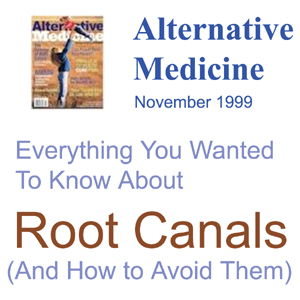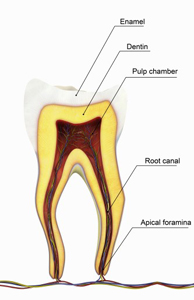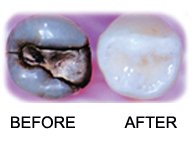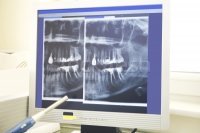avoid root canals

 avoid root canals
avoid root canals
MOST DENTISTS CONSIDER ROOT CANALS an advance in dentistry --a superior alternative to removal of a seriously compromised tooth. However a growing number of physicians, including dentists, believe that root canals can be the cause of, or at least contribute to, a long list of illnesses and degenerative diseases. avoid root canals
One dentist who wants the number of root canals performed to plummet rather than rise is Dr. Richard Hansen, D.M.D., Director of the Center for Advanced Dentistry in Fullerton, California. Dr. Hansen is recognized as one of the world's foremost experts on laser dentistry. The latest generation of laser equipment and techniques affords people an option to avoid conventional root canals, repair previously performed dental work, and prevent the need for root canals in the future.
Alternative Medicine editor, Tom Kiaber, recently interviewed Dr. Hansen on the state of the art.
ALTERNATIVE MEDICINE (ALTMED): Dr. Hansen, why are the huge numbers of root canals being performed, and why is the number rising? Is it just because the population is increasing, or getting older; are our teeth getting worse; or are dentists just choosing to do this?
avoid root canals
DR. HANSEN (DR.H): There are a combination of factors. Number one, contemporary dentists have been trying to save teeth more and more, rather than just taking them out and making dentures, like they used to do in the past. So they've been going to the root canal as a procedure to help save teeth. Also, dentists have been using amalgams and doing more crowns over time. Those more invasive procedures have traumatized the nerve, causing it pain, cumulative damage, and resulting in its injury and death. This has led towards more root canals being done as well. I really can't stress enough that I hope that statistic can actually be reversed. And that the numbers of root canals or the need for root canals decreases because of changing our dental procedures.
avoid root canals
ALTMED: What procedures do you feel should be changed and how should they be changed?
avoid root canals
DR.H: First, stop grinding down a kid's perfectly good tooth with a small cavity to put in a big silver filling. I think that should be malpractice today. Instead, you could use a laser to just pinpoint the target area and remove the decay, inject in flowable, tooth-colored material, infuse it to the tooth and keep most of the tooth intact.
avoid root canals
ALTMED: How exactly does a laser work, as opposed to a drill?
avoid root canals
DR.H: A drill basically grinds away everything in its path. And it sets up heat, friction and vibration that traumatize the nerve. A laser; on the other hand, works very specifically on only the diseased part of the tooth. Decayed tooth has an extremely high water content, compared to healthy tooth. Because of that, the laser can be selectively targeted to vaporize only the decay area. It does it in such a kind way that, in almost all cases, you never need anesthetic. It doesn't cause any reaction to the nerve of the tooth.
ALTMED: How do you set the intensity of the laser; to vaporize only the decayed material?
avoid root canals
DR.H: We set that on the machine, by selecting different power densities. At low density, only decay area vaporizes. If it's not decayed, it won't have an effect on it. However; it is still also a matter of touch.
ALTMED: After you've vaporized, the decayed portion of the tooth, do you sterilize it somehow?
avoid root canals
DR.H: The laser does that automatically while it's working. That's the other beauty of it. The sterility factor precedes any vaporization. The drill cannot, absolutely cannot, sterilize. In fact, the drill pushes bacteria deeper into the tooth.
ALTMED: How do you fill the cavity?
avoid root canals
DR.H: We use injectable tooth-colored composite, or ceramic-filled composite. You just inject it into the tiny little areas from which you've removed the decay. Then you harden it with another laser and it fuses with the tooth.
avoid root canals
ALTMED: So you can remove tooth decay, sterilize the cavity, and fill it without using anesthetic?
avoid root canals
DR.H: Absolutely. We do that every single day.
ALTMED: How does the cost of laser dentistry compare to a regular filling?
avoid root canals
DR.H: The costs are anywhere from 30% to 50% higher for a normal simple filling. But a regular filling specially a silver filling will probably have to have replaced with larger fillings. You may not ever need to have a laser filling replaced. But the real cost savings is that, by not traumatizing the tooth, you're avoiding further dental work and possibly serious health conditions in the future -- such as root canals.
ALTMED: What other aspects of basic dentistry do you think need to be changed to help prevent root canals?
avoid root canals
DR.H: Again, we start with the basics for kids and early cavities, like we just described. With adults, fillings often need to be replaced when a silver-mercury amalgam leaks or fails, or they get new cavities, or have an infected nerve. I have pioneered a technique for infected nerves that I'm hoping to get FDA clearance on. This is where, instead of doing a root canal, we can do a laser nerve treatment on that bleeding, infected nerve and make it healthy again.
ALTMED: You can use the laser to just selectively clean the infected part and still keep most of the nerve?
avoid root canals
DR.H: Exactly. We've been doing this now for a little over 2½ years, with almost 100% success. In fact, I don't think we've lost one tooth, or had to perform a root canal on any of these.
ALTMED: I can understand how a laser could vaporize only decayed tooth material. But a nerve seems much more delicate.
avoid root canals
DR.H: And it is. But that's the beauty of what this new generation laser is all about. It is so delicate. It's the same laser they're using on skin resurfacing, with which you can literally just take a cell layer off the surface of the skin of the face, and have the underlying layers not be affected. Inside of a tooth, with a diseased nerve, we can remove the layers of the disease and keep the live nerve underneath very comfortable and very healthy.
ALTMED: What do you do alter you have vaporized the infected portion of a nerve inside a tooth?
avoid root canals
DR.H: We put on a medicated seal we call it a pulp cap-made of a special antibacterial/anti-inflammatory mixture, right over the area of infection. Then we seal that over with hard glass, injectable resins, like we do with the small cavities. We add a new floor to the interior of the tooth. Instead of doing a crown, where we have to grind away all of the outer surface, we just make up a tooth replacement inlay that can go inside the tooth and fuse it all together again.
avoid root canals
The limitation with most of the crowns has been the strength of the cement. Cement has a relatively weak bond and is somewhat water soluble by saliva. Therefore, you need to grind away a large amount of tooth to create a large surface area in order for the cement to hold. The more tooth you grind away, or is missing with decay, the more likely it is that the cement bond will fail. We see that routinely. Many, many crowns have to be replaced over time. Usually, more of the tooth is damaged. And, like we described at the beginning, the more treatment you do on a tooth with a dentist's drill, the more likely that tooth's nerve is going to die and need a root canal. We are finding that very many of the older crowned, especially replacement crowned teeth, need to have root canals these days. That's a big reason why the number of root canals is increasing each year.
ALTMED: What kinds of problems do conventional root canals have?
avoid root canals
DR.H: After nerve and bone trauma, the second biggest problem associated with the traditional root canal is what happens to the material inside the dentine tubules.
ALTMED: What are dentine tubules?
avoid root canals
DR.H: The whole root of the tooth is composed of about a 70% calcified structure. within this calcified structure-called dentine are micro-tubules, tiny hollow tubes, that run from the inner chamber, the pulp or nerve chamber of the tooth, through the wall of the tooth to the outside. They have projections within them that come off of the nerve, called odontoblasts. They contract and expand and send messages to the nerve. They tell the nerve if there is a stimulus that is harmful to the tooth. Essentially, they react to pain. This is how drilling is a problem. The drill grinding the tooth creates a trauma that the odontoblasts, through the tubules, will communicate to the nerve. The nerve produces an inflammatory reaction to it and starts walling itself off. Or more calcified structure is added to the area where the irritant is. The problem is that the tooth starts getting too much swelling within it from this inflammation. The root canal in the tooth is a tight lirile chamber. The pressure shuts off the lymphatic drainage, so toxins aren't removed. And it shuts off the blood supply necessary to repair the nerve. The extra pressure can start the nerve to degenerate and die. That's why the tooth starts hurting and ends up needing a root canal.
ALTMED: How does the root get infected?
avoid root canals
DR.H: In most people, throughout their life, these tubules shrink in size and fill in with minerals, but many remain open. It's these tubules that with the normal root canal procedure you cannot get cleaned out. You cannot sterilize them. And you cannot fill them with normal root canal procedures. The number one filling material used. in almost all conventional root canals, is gutta-percha, which is a latex material. A significant portion of the population has become allergic to latex. And, because gutta-percha doesn't show up on x-rays very well, they've added 20% heavy metal mixtures. The normal heavy metals that are added are either mercury salt, cadmium, barium, or lead. They're implanting this latex/heavy metal material into every single root canal tooth. Gutta-percha, while it may fill the inner chamber of the canal, the dentine tubules that are open may still become a haven for bacteria. This is where alternative dentists see the big problem with a lot of the root canals done with the potential for infection created by the bacteria in the dentine tubules. In our practice we can sterilize the tubules with the laser. And then occlude (seal) the tubules with calcium oxide to keep them from transmitting bacteria.
ALTMED: Please tell me about some of your other techniques. Let's say I come in as a first-time patient and I say, "Dr. Hansen, my tooth hurts." What do you do?
avoid root canals
DR.H: The first thing we'll do is assess the reason why. We'll take computerized x-rays to assess it.
ALTMED: Excuse me, what is the difference between computerized and regular x-rays?
avoid root canals
DR.H: By using a computer to enhance the images we can reduce the amount of x-ray exposure by 90%. We have a digital sensor we put in the mouth instead of film. It produces a greatly enhanced image. You can then look at the density and the exactness of the tooth and the bone and get a better image, with less radiation. We can alter the density patterns to enhance the xrays so we can see these lesions in the bone and the teeth better. We can get exact measurements from the computer for the tooth and the length of the root and where the location of the problem is.
ALTMED. OK, what do you do next?
avoid root canals
DR.H: We have electronic testing devices that measure the vitality of the tooth.
ALTMED: Like acupuncture meridian testing?
DR.H: Exactly, like electrodermal screening, with which we test the strength of organs by measuring the changes in electrical conductivity along the associated meridians. Then we try and assess to see why the nerve is hurting Is there a cavity in the tooth? Is there a large filling restoration in the tooth that might have damaged or traumatized the nerve? Is there a crown on the tooth, where the dentist had to use a lot of drilling to trim the tooth away?
Or in a normal tooth, is there a fracture? For that, we use a small intra-oral camera with a high-intensity light on it. We put the little camera around and on the tooth and visually look for these fractures or lesions. We can see them better thin we ever could with a little mirror and an x-ray. We can put the image on a TV screen in front of you, blown up 35 times from what you could ever see in the mouth. We get so much detail and information that we can really see what the problems are.
ALTMED: All right. Now, you've looked at my tooth and determined whether it's a crown that's causing problems or there's a fracture, or there's a cavity....
DR.H: Or bad blood supply. If it's that, we have a laser that we use to stimulate lymphatic drainage and stimulate the reduction of inflammation, to help with the circulation within the tissue. It's a low level laser stimulation on the outside. It's a form of light acupuncture. Light acupuncture usually employs infrared laser energy and red laser energy. Our device penetrates deeper to get into the bone and around the teeth.
ALTMED: What other scenarios might you have?
DR.H: If it's not circulation, it might be a cavity that's close to the nerve. We'd use the laser to go ahead and do a laser nerve treatment remove the diseased portion, seal up the nerve and make it well again, as I described before.
If it's a fracture, rather than grind the whole tooth down for a crown, we would go ahead and just repair the fracture internally and fuse it together again. If it's a filling that's cracked or broken, we just take out the diseased portion, repair the fracture and make up a tooth-replacement to fuse the tooth together. In all of the those cases, we can prevent having the need for a root canal.
ALTMED: After the treatment is complete, is support therapy needed?
DR.H: Oh, yes. Nutrition. Low-level lasers to keep the circulation going. Good chelation, detoxification means.
ALTMED: Are you allowed to do that?
DR.H: No, by state law, as dentists, we can't even offer nutritional counseling. But we refer our patients to appropriate counselors and practitioners.
One other thing that we can offer our patients is hyperbaric oxygen chambers. And ionized oxygen, which the patient can just breathe in, before and after the procedure. It oxygenates the tissues. It makes the whole energy state of the whole body more healthy, and better able to deal with dental work.
ALTMED: I understand you do follow-up monitoring of your patients using fluid testing and bone biopsies.
Dr.H: Right. And electrodermal screening. It can tell us if we have a focus of infection in the mouth or have some type of blockage or frictional blockage within another part of the body. We can check the long term success and make sure we have a healthy environment and biological terrain.
ALTMED: A healthy environment in the mouth, or in the entire body?
Dr.H: Of course they influence each other. How do you recreate health in the tissues? I basically have gone on the premise that this body that God has created should be able to fix itself. In any area of alternative medicine we have that same basic premise. Before we use the invasive modalities-surgery, drugs, radiation-we should try and exhaust all of the alternative steps to make the body function and to work on its own. Bombarding it with potent drugs or cutting things out with surgery can make it worse.
ALTMED: That is the basis of alterative medicine.
Dr.H: Absolutely. I look at even laser root canals as an option, and extraction as a last resort. We shouldn't use a treatment of last resort for the first resort.
For more information on this subject, visit The Healthy Root Canal website.
Top of Page
Return from "Avoid Root Canals" to Home Page.




 avoid root canals
avoid root canals